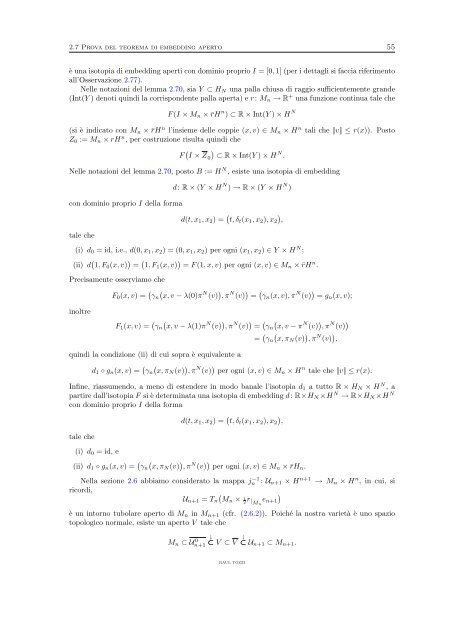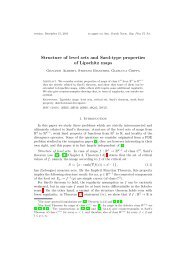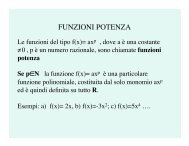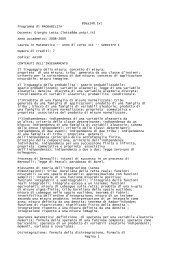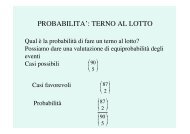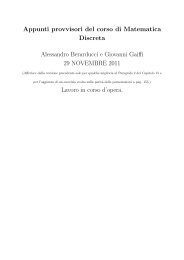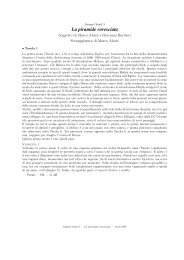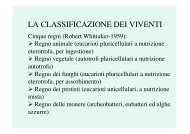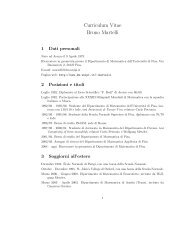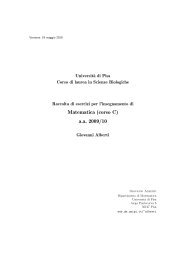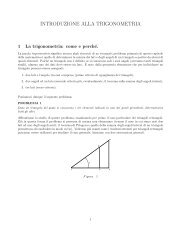Immersioni aperte in dimensione infinita - Dipartimento di Matematica
Immersioni aperte in dimensione infinita - Dipartimento di Matematica
Immersioni aperte in dimensione infinita - Dipartimento di Matematica
Create successful ePaper yourself
Turn your PDF publications into a flip-book with our unique Google optimized e-Paper software.
2.7 Prova del teorema <strong>di</strong> embedd<strong>in</strong>g aperto 55<br />
è una isotopia <strong>di</strong> embedd<strong>in</strong>g aperti con dom<strong>in</strong>io proprio I = [0, 1] (per i dettagli si faccia riferimento<br />
all’Osservazione 2.77).<br />
Nelle notazioni del lemma 2.70, sia Y ⊂ HN una palla chiusa <strong>di</strong> raggio sufficientemente grande<br />
(Int(Y ) denoti qu<strong>in</strong><strong>di</strong> la corrispondente palla aperta) e r : Mn → R + una funzione cont<strong>in</strong>ua tale che<br />
F (I × Mn × ¯rH n ) ⊂ R × Int(Y ) × H N<br />
(si è <strong>in</strong><strong>di</strong>cato con Mn × ¯rH n l’<strong>in</strong>sieme delle coppie (x, v) ∈ Mn × H n tali che |v | ≤ r(x)). Posto<br />
Z0 := Mn × rH n , per costruzione risulta qu<strong>in</strong><strong>di</strong> che<br />
F N<br />
I × Z0 ⊂ R × Int(Y ) × H .<br />
Nelle notazioni del lemma 2.70, posto B := H N , esiste una isotopia <strong>di</strong> embedd<strong>in</strong>g<br />
d: R × (Y × H N ) → R × (Y × H N )<br />
con dom<strong>in</strong>io proprio I della forma<br />
d(t, x1, x2) = <br />
t, δt(x1, x2), x2 ,<br />
tale che<br />
(i) d0 = id, i.e., d(0, x1, x2) = (0, x1, x2) per ogni (x1, x2) ∈ Y × H N ;<br />
(ii) d 1, F0(x, v) = 1, F1(x, v) = F (1, x, v) per ogni (x, v) ∈ Mn × ¯rH n .<br />
Precisamente osserviamo che<br />
F0(x, v) = N N<br />
γn x, v − λ(0)π (v) , π (v) = γn(x, v), π N (v) = gn(x, v);<br />
<strong>in</strong>oltre<br />
F1(x, v) = <br />
N N N N<br />
γn x, v − λ(1)π (v) , π (v) = γn x, v − π (v) , π (v)<br />
= <br />
γn x, πN(v) , π N (v) ,<br />
qu<strong>in</strong><strong>di</strong> la con<strong>di</strong>zione (ii) <strong>di</strong> cui sopra è equivalente a<br />
d1 ◦ gn(x, v) = <br />
γn x, πN(v) , π N (v) per ogni (x, v) ∈ Mn × H n tale che |v | ≤ r(x).<br />
Inf<strong>in</strong>e, riassumendo, a meno <strong>di</strong> estendere <strong>in</strong> modo banale l’isotopia d1 a tutto R × HN × HN , a<br />
partire dall’isotopia F si è determ<strong>in</strong>ata una isotopia <strong>di</strong> embedd<strong>in</strong>g d: R×HN ×H N → R×HN ×H N<br />
con dom<strong>in</strong>io proprio I della forma<br />
d(t, x1, x2) = <br />
t, δt(x1, x2), x2 ,<br />
tale che<br />
(i) d0 = id, e<br />
(ii) d1 ◦ gn(x, v) = <br />
γn x, πN(v) , πN (v) per ogni (x, v) ∈ Mn × ¯rHn.<br />
Nella sezione 2.6 abbiamo considerato la mappa j −1<br />
n : Un+1 × H n+1 → Mn × H n , <strong>in</strong> cui, si<br />
ricor<strong>di</strong>,<br />
<br />
Un+1 = Tn Mn × 1 2r <br />
| en+1 Mn<br />
è un <strong>in</strong>torno tubolare aperto <strong>di</strong> Mn <strong>in</strong> Mn+1 (cfr. (2.6.2)). Poiché la nostra varietà è uno spazio<br />
topologico normale, esiste un aperto V tale che<br />
Mn ⊂ U 0 n+1<br />
↓<br />
⊂ V ⊂ V ↓<br />
⊂ Un+1 ⊂ Mn+1.<br />
RAUL TOZZI


